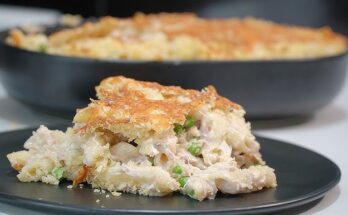Sourdough English Muffin Recipe: If you’ve never bitten into a fresh, homemade sourdough English muffin, you’re missing out. The combination of tangy sourdough flavor with a soft, chewy interior and that signature nooks-and-crannies texture is simply divine. These muffins are miles apart from the store-bought versions—fresh, flavorful, and full of love. They’re perfect for breakfast sandwiches, toasted with butter, or even as a base for Eggs Benedict.
Sourdough English muffins are a fun and rewarding project for any home baker. They require some patience due to fermentation, but the process is surprisingly straightforward and doesn’t involve baking in an oven. Yes, you cook them on a skillet! Whether you’re a sourdough enthusiast or a beginner, this recipe will walk you through the entire process—step-by-step.
Why Make English Muffins with Sourdough Starter?
Using sourdough starter instead of commercial yeast isn’t just trendy—there are real benefits. First, it delivers a rich, tangy depth of flavor that can’t be replicated with yeast alone. Second, the natural fermentation process breaks down gluten, making the muffins easier to digest. Sourdough can also help with blood sugar regulation due to its lower glycemic index.
In addition, using your sourdough discard or active starter is a great way to avoid waste. If you bake sourdough bread regularly, this recipe will become your favorite way to make the most of your bubbly friend sitting on the counter. Plus, there’s something uniquely satisfying about transforming simple ingredients into something so delicious, all with the power of fermentation.
Essential Ingredients You’ll Need
Core Ingredients for the Dough
To make 8 to 10 sourdough English muffins, gather the following:
- Sourdough starter (active and bubbly) – 1/2 cup (about 120g)
- All-purpose flour – 3 cups (360g)
- Milk – 1 cup (240ml), warm
- Butter (melted) – 2 tablespoons (optional for extra richness)
- Sugar or honey – 1 tablespoon
- Salt – 1 teaspoon
- Cornmeal – for dusting the surface
You can customize the recipe by adding whole wheat flour or substituting plant-based milk for a vegan version. The flavor and texture may vary slightly, but it still works beautifully.
Tools & Equipment Checklist
Before you begin, make sure you have:
- Mixing bowl
- Dough scraper or spatula
- Measuring cups and spoons or a kitchen scale
- Skillet or griddle (cast iron works best)
- Rolling pin (optional)
- Biscuit cutter or a large glass (about 3 inches wide)
- Parchment paper or clean kitchen towel
- Cooking thermometer (optional for precision)
Getting organized before you start makes the process smoother and more enjoyable.
Step-by-Step Instructions to Make Sourdough English Muffins
Step 1: Feed Your Sourdough Starter
Timing is key! Feed your sourdough starter about 4 to 8 hours before mixing the dough, depending on room temperature. You want it active and bubbly—double in size and full of life. If you’re using discard, it still works, but your muffins may be slightly less airy and rise slower.
Tip: Use the float test—drop a small spoon of starter into water. If it floats, it’s ready.
Step 2: Mix the Dough
In a large bowl, combine your active sourdough starter, warm milk, melted butter, sugar, and flour. Mix until a sticky dough forms. Add salt last and knead gently for 5-8 minutes until smooth and elastic.
Don’t worry if it’s a bit tacky—that’s normal. Cover the bowl with plastic wrap or a damp towel and let it rest for 30 minutes. This short rest (autolyse) helps hydrate the flour and begins gluten development naturally.
Step 3: Bulk Fermentation
Cover the bowl and let the dough rise at room temperature for 6–8 hours or overnight (for maximum flavor). It should double in size and have visible bubbles. This is where the magic happens—the lactic acid bacteria and wild yeast create that signature sour flavor.
If your kitchen is cold, consider putting the bowl in a turned-off oven with the light on or near a warm window.
Step 4: Shaping the Muffins
Once your dough has finished fermenting and has doubled in size, it’s time to shape the muffins. Turn the dough out onto a floured surface and gently pat it into a rectangle about ¾ to 1 inch thick. Avoid overworking the dough—you want to keep those beautiful fermentation bubbles intact.
Using a biscuit cutter or a glass, cut out circles of dough. If the dough is sticky, dust your cutter with flour between each cut. Re-roll any scraps and cut again. Place each muffin onto a baking sheet or tray dusted generously with cornmeal. The cornmeal adds that signature crunchy texture on the bottom and prevents sticking.
Sprinkle a little more cornmeal on top, cover the muffins with a clean towel, and let them rest for 1–2 hours. This resting time, also known as proofing, allows the shaped muffins to puff up slightly and build more structure before cooking.
Step 5: Second Rise
During this final proof, the dough will become slightly more airy and puffy. If your kitchen is cool, allow extra time—don’t rush it. You’re looking for a gentle rise, not a dramatic one.
This step is crucial. If you cook them too early, they’ll be dense. But if you wait too long, they may collapse on the skillet. When you gently press the dough, it should spring back slowly, not immediately.
Pro tip: If you want to time your breakfast right, you can do this second rise overnight in the fridge. Just shape the muffins, cover, and refrigerate. The next morning, let them come to room temperature for 30–45 minutes before cooking.
Step 6: Cook on a Skillet
Now for the fun part—cooking! Heat a heavy-bottomed skillet or griddle over medium-low heat. Don’t go too hot—you want a slow, even cook to ensure the centers bake through without burning the outsides.
Place the muffins onto the dry skillet (no oil needed), leaving enough space between them. Cook for about 6–8 minutes per side, turning once. They should be golden brown and slightly puffed.
To ensure they’re cooked through, you can insert a thermometer—the internal temperature should be about 200°F (93°C). If you don’t have a thermometer, you can finish them in a 350°F (175°C) oven for 5–7 minutes after skillet cooking.
Let them cool on a wire rack for at least 10 minutes before slicing open. Resist the urge to dig in too soon—cutting them hot can make them gummy inside.
Pro Tips for Fluffy and Tangy Muffins
- Use a strong starter: Your sourdough starter should be active, bubbly, and well-fed. This is key for rise and flavor.
- Don’t over-flour: The dough should be slightly sticky. Too much flour can make muffins dense and dry.
- Low and slow is the way: Cooking over medium-low heat ensures the inside gets cooked without burning the outside.
- Use cornmeal generously: It adds texture and keeps the dough from sticking while proofing and cooking.
- Fork-split instead of slicing: To keep the nooks and crannies intact, use a fork to split the muffins open after cooling.
Common Mistakes to Avoid
- Skipping fermentation time: Rushing the bulk fermentation will result in a flat flavor and poor texture.
- Cooking too fast: High heat can burn the outside while leaving the center doughy.
- Over-proofing the dough: If the muffins rise too long, they’ll collapse when cooked.
- Cutting hot muffins: Let them cool before slicing to avoid a gummy texture.
- Inconsistent thickness: Roll the dough evenly so all muffins cook at the same rate.
How to Store and Reheat Sourdough English Muffins
Once your sourdough English muffins have cooled completely, proper storage is essential to maintain their freshness and texture.
Room Temperature Storage: If you plan to eat them within a few days, store them in an airtight container or zip-top bag at room temperature for up to 3 days. Be sure they are completely cool before sealing them up to avoid condensation, which can lead to sogginess.
Freezing for Later: Want to batch cook? These muffins freeze wonderfully. Just slice them first (so you can pop them straight into the toaster later), and place a small piece of parchment between the halves to prevent sticking. Store in a freezer-safe bag for up to 3 months.
Reheating Tips:
- Toaster: The best method. Toast on medium to high to bring back the crisp edges and soft interior.
- Oven: Preheat to 350°F (175°C) and bake for 5–10 minutes.
- Microwave: Only in a pinch—wrap in a damp paper towel and microwave for about 20 seconds. Be warned, this may soften the texture too much.
Serving Suggestions and Pairings
Sourdough English muffins are incredibly versatile. Here are some delicious ways to serve them:
1. Classic with Butter and Jam
Toast and slather with salted butter, then add a layer of homemade jam or marmalade. Simple and heavenly.
2. Breakfast Sandwiches
Top with scrambled or fried eggs, cheese, and bacon or sausage for a hearty breakfast sandwich. You can also go vegetarian with spinach, avocado, and tomato.
3. Eggs Benedict
These muffins are the traditional base for Eggs Benedict. Top with poached eggs, Canadian bacon, and hollandaise sauce. Pure brunch bliss.
4. Avocado Toast Upgrade
Skip the toast—spread mashed avocado on a toasted English muffin, sprinkle with chili flakes, lemon juice, and feta.
5. Mini Pizzas
Great for a quick lunch or snack. Just add marinara, cheese, and your favorite toppings, then broil until bubbly.
The tangy, chewy texture of sourdough pairs beautifully with savory, sweet, and spicy flavors alike. Get creative!
Nutritional Information (Per Muffin)
Here’s an estimate based on a batch of 10 muffins, using traditional ingredients:
| Nutrient | Amount (Per Muffin) |
|---|---|
| Calories | 160–180 kcal |
| Protein | 4–5g |
| Fat | 3–5g |
| Carbohydrates | 28–30g |
| Fiber | 1g |
| Sugar | 1–2g |
| Sodium | 180–200mg |
Keep in mind, the actual values may vary depending on the exact ingredients used and serving size. If you’re adding toppings like butter or eggs, that will naturally increase the calorie count.
FAQs about Sourdough English Muffin Recipe
1. What makes sourdough English muffins different from regular English muffins?
Sourdough English muffins differ primarily due to the fermentation process. Using a sourdough starter, these muffins have a distinct tangy flavor and a chewier texture compared to those made with commercial yeast, which tend to be softer and milder.
2. Can I use all-purpose flour instead of bread flour for the muffins?
Yes, you can use all-purpose flour, but the texture might be slightly different. Bread flour has a higher protein content, which gives the muffins a more robust structure and chewiness. All-purpose flour will make them a bit softer and less chewy.
3. How long do I need to ferment the sourdough for the muffins?
The fermentation time can vary based on your kitchen’s temperature and the activity of your sourdough starter. Typically, an overnight ferment of about 12 to 18 hours at room temperature is recommended for optimal flavor and texture.
4. Do sourdough English muffins need baking powder or baking soda?
Traditionally, sourdough English muffins do not require baking powder or baking soda. The natural leavening from the sourdough starter is sufficient. However, some recipes add a small amount of baking soda to neutralize the acidity and help the muffins rise better.
5. How do I get the classic “nooks and crannies” in my sourdough English muffins?
The key to achieving those desirable nooks and crannies is in the dough’s hydration and handling. A wetter dough, gentle handling, and proper cooking on a griddle or skillet at the right temperature help form the characteristic texture.
6. Can I freeze sourdough English muffins?
Absolutely! Sourdough English muffins freeze well. Simply cool them completely after baking, slice them if you prefer, and store in a freezer-safe bag. They can be toasted straight from frozen for a convenient breakfast option.
7. What’s the best way to serve sourdough English muffins?
Sourdough English muffins are versatile! Enjoy them toasted with butter, used as the base for a delightful eggs Benedict, or with your favorite spreads and sandwich fillings. They’re particularly good when toasted, as this enhances their texture and flavor.
Conclusion
There’s something truly magical about turning a few basic ingredients into something as delightful as sourdough English muffins. From the tangy flavor to the soft, chewy bite and crispy golden edges, every step of this recipe brings you closer to the kind of breakfast dreams are made of.
Whether you’re a seasoned baker or just getting started on your sourdough journey, this recipe is an excellent way to level up your breakfast game. It’s forgiving, customizable, and ridiculously tasty. Plus, nothing beats the satisfaction of making your own English muffins from scratch—your toaster will thank you.
Give it a try this weekend, and once you taste that homemade magic, you’ll never look at store-bought muffins the same way again.



